This is another one of those posts for a niche audience. If you found this post, you’re likely looking for information about:
- Running after a broken ankle (or are coming from my “tips for returning to weight bearing” and looking for an update from me, two years after my trimalleolar ankle fracture)
- Running with the “Galloway method”, also known as run-walk or run/walk methods for marathon or similar long distances – but with information about run-walking for slow runners.
- Running a marathon with type 1 diabetes, or running an ultra with type 1 diabetes
- Running a marathon and training for a marathon and going without fuel or less fuel
*Update: also running an ultramarathon with the same methods (less fuel than typical)!
There’s a bit of all of this in the post! (But TLDR – I ran my marathon (finally), successfully, despite having a previously broken ankle. And despite running it with type 1 diabetes, I had no issues managing my blood sugars during even the longest training runs, even with significantly less fuel than is typically used by marathon runners. I also ran a 50k ultra using the same methods!)
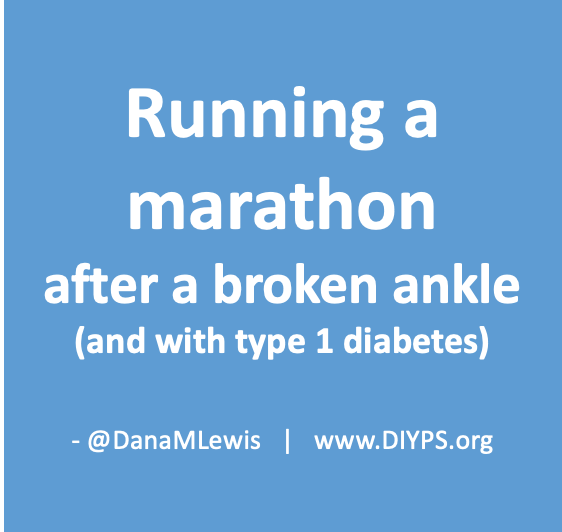
First up, some context that explains why I chose run-walking as my method of running a marathon (as that also influences fueling choices) and what it is like to be a slow marathon runner (6 hour marathon ish). I broke my ankle in January 2019 and began running very tiny amounts (literally down the block to start) in summer 2019. I progressed, doing a short run interval followed by a walk interval, increasing the total numbers of intervals, and then slowly progressing to extend the length (distance and/or time) of the running intervals. In early fall 2019, I was attempting a couch-to-5k type program where I would extend my running intervals even longer, but I still had subsequent injuries (a very stubborn big toe joint, then intermetatarsal bursitis in TWO spots (argh)) that made this not work well. Eventually, I went back to running 30 seconds and walking 30 seconds, then keeping those “short” intervals and extending my run. I focused on time at first: going from 5 to 10 to 15 to 20 etc minutes, rather than focusing on distance. Once I built up to about 30 minutes of run-walking (30:30, meaning running 30 seconds and walking 30 seconds), I switched to adding a quarter or half mile each time depending on how I was feeling. But doing 30:30 seemed to work really well for me in terms of the physical impact to my feet, even with long miles, and also mentally, so I stuck with it. (You can go read about the Galloway run-walk-run method for more about run-walking; most people build up to running more, say 5 minutes or 8 minutes followed by a minute of walking, or maybe run 1 mile and then walk for a minute, or walk through the aid stations, but I found that 30:30 is what I liked and stuck with it or 60:30 as my longest intervals.)
This worked so well for me that I did not think about my right ankle a single time during or after my marathon! It took days to even remember that I had previously broken my ankle and it could’ve been problematic or weaker than my other ankle during my marathon. It took a long time to get to this point – I never thought I’d be forgetting even for a few days about my broken ankle! But two years later, I did.)
When COVID-19 struck, and as someone who paid attention early (beginning late January 2020), I knew my marathon would not be taking place in July 2020 and would be postponed until 2021. So I focused on keeping my feet healthy and building up a running “base” of trying to stay healthy feet-wise running twice a week into fall 2020, which worked fairly well. At the start of 2021, I bumped up to three runs a week consistently, and eventually began making one run every other a week longer. My schedule looked something like this:
Monday – 3 miles Wednesday – 3 miles Friday – 3 miles
Monday – 4 miles Wednesday – 3 miles Friday – 3 miles
Monday – 5 miles Wednesday – 3 miles Friday – 3 miles
Monday – 6 miles Wednesday – 3 miles Friday – 3 miles
Monday – (back to) 3 miles Wednesday – 3 miles Friday – 3 miles
Monday – 8 miles Wednesday – 3 miles Friday – 3 miles
Monday – (back to) 3 miles Wednesday – 5 miles Friday – 4 miles
Monday – 10 miles Wednesday – 3 miles Friday – 3 miles
Note that these runs I refer to were all technically run-walks, where I ran 30 seconds and walked 30 seconds (aka 30:30) until I covered the miles. I was running slow and easy, focusing on keeping my heart rate below its maximum and not worrying about speed, so between that and run-walking I was often doing 15m30s miles. Yes, I’m slow. This all enabled me to build up to safely be able to run 3 runs weekly at first, and then eventually progressed to adding a fourth run. When I added a fourth run, I was very conservative and started with only 1 mile for two weeks in a row, then 2 miles, then up to 3 miles. Eventually, later in my training, I had some of my other runs in the week be a bit longer (4-5 miles) in addition to my “long” run.
But, because I’m so slow, this means it takes a lot of time to run my long runs. If you estimate a 15-minute mile for easy math, that means an 8 mile “long” run would take at least 2 hours. With marathon training (and my goal to train up to multiple 22-24 mile runs before the marathon), that took A LOT of time. And, because of my broken ankle and intermetatarsal experiences from 2019, I was very cautious and conservative about taking care of my feet during training. So instead of following the usual progression of long runs increasing 2-3 weeks in a row, followed by a “cutback” long week, after I hit two hours of long running (essentially 8 miles, for me), I started doing long runs every other week. The other week was a “cutback” long run, which was usually 8 miles, 10 miles (for several weeks), up to eventually 12-14. In terms of “time on feet”, this meant 2-3 hours “cutback” long runs, which according to many people is the max you should be running for marathon training. That doesn’t quite work for slow runners such as myself where you might be doing a 6-hour marathon or 7-hour marathon or thereabouts. (The standard advice also maybe doesn’t apply when you are doing run-walking for your marathon training.)
I had ~6 months to build up to my marathon (from January to the end of July), so I had time to do this, which gave me a buffer in my overall training schedule in case of scheduling conflicts (which happened twice) and in case of injury (which thankfully didn’t happen). I ended up scheduling training long runs all the way to full marathon distance (26ish miles), because I wanted to practice my fueling (especially important for type 1 diabetes marathon runners, which I’ll talk about next) as well as get my feet used to that many hours of run-walking. I did my long runs without care for speed, so some of them were closer to 16-minute mile averages, some were around 15-minute mile averages for the entire run, and the day I ran the full marathon course for training I ended up doing 16+ minute miles and felt fabulous at the end.
I ended up doing a few “faster” “shorter” long runs (on my cutback weeks), where I would do a half marathon-ish distance on the actual marathon course (a public trail), and try to go faster than my super slow long run pace. I had several successful runs where I was at or near marathon pace (which for me would be around 13m30s). So yes, you can train slow and run fast for a marathon, even without much speed work, and even if you are doing a run-walk method, and even if you’re as slow as I am. Running ~15-minute miles took forever but kept my feet and body healthy and happy through marathon training, and I was still able to achieve my sub-6 hour marathon goal (running 13:41 average pace for 26.2+ miles) on race day.
Now let’s talk about fueling, and in particular fueling for people with type 1 diabetes and for people wondering if the internet is right about what fueling requirements are for marathon runners.
I previously wrote (for a T1D audience) about running when fasted, because then you don’t have to deal with insulin on board at the start of a run. That’s one approach, and another approach is to have a smaller meal or snack with fewer carbs before the run, and time your run so that you don’t need to bolus or inject for that meal before you start your run. That’s what I chose for most of my marathon training, especially for longer runs.
On a typical non-running day, I would eat breakfast (½ cup pecans, ¼ cup cranberries, and a few sticks of cheese), my OpenAPS rig would take care of insulin dosing (or I could bolus for it myself), and my BGs would be well managed. However, that would mean I had a lot of insulin on board (IOB) if I tried to run within an hour of that. So instead, during marathon training, I ended up experimenting with eating a smaller amount of pecans (¼ cup) and no cranberries, not bolusing or letting OpenAPS bolus, and running an hour later. I had a small BG rise from the protein (e.g. would go from 100 mg/dL flat overnight to 120-130 mg/dL), and then running would balance out the rest of it.
I generally would choose to target my blood sugar to 130 mg/dL at the start of long runs, because I prefer to have a little bit of buffer for if/when my blood sugar began to drop. I also figured out that if I wasn’t having IOB from breakfast, I did not need to reduce my insulin much in advance of the run, but do it during the duration of the run. Therefore, I would set a higher temporary target in my OpenAPS rig, and if I was doing things manually, I would set a temporary basal rate on my insulin pump to about ⅓ of my usual hourly rate for the duration of the run. That worked well because by the time the beginning of my run (30-45 minutes) brought my BG down a little bit from the start with the protein breakfast bump (up to 130 mg/dL or so), that’d also be when the reduced insulin effect would be noticeable, and I would generally stay flat instead of having a drop at the beginning or first hour of my run.
After my first hour or so, I just kept an eye periodically on my blood sugars. My rule of thumb was that if my BG drifted down below 120 mg/dL, I would eat a small amount of carbs. My carb of choice was an individually wrapped peppermint (I stuffed a bunch in my pocket for the run) that was 3-4g of carb. If I kept drifting down or hadn’t come back up to 120 mg/dL 10-15 minutes later, I would do another. Obviously, if I was dropping fast I would do more, but 75% of the time I only needed one peppermint (3-4g of carb) to pause a drift down. If you have a lot of insulin on board, it would take more carbs, but my method of not having IOB at the start of long runs worked well for me. Sometimes, I would run my entire long run with no carbs and no fuel (other than water, and eventually electrolyte pills). Part of this is likely due to the fact that I was run-walking at such low intensity (remember 15-ish minute miles), but part of this is also due to figuring out the right amount of insulin I needed for endurance running and making sure I didn’t have excess insulin on board. On my faster runs (my half marathon distance fast training runs, that were 2+ minutes/mile faster than my slow long runs) and my marathon itself, I ended up needing more carbs than a super slow run – but it ended up being about 30 grams of carbohydrate TOTAL.
Why am I emphasizing this?
Well, the internet says (and most coaches, training plans, etc) that you need 30g of carbs PER HOUR. And that you need to train your stomach to tolerate that many carbs, because your muscles and brain need it. And without that much fuel, you will ‘hit the wall’.
My hypothesis, which may be nuanced by having type 1 diabetes and wearing a CGM and being able to track my data closely and manage it not only by carbs but also titrating insulin levels (which someone without diabetes obviously can’t do), is that you don’t necessarily need that many carbs, even for endurance running or marathon running.
I’m wondering if there’s a correlation between people who max out their long runs around 16-20 miles and who then “hit the wall” around mile 20 of a marathon. Perhaps some of it is muscle fatigue because they haven’t trained for the distance and some of it is psychological of feeling the brain fatigue.
During my marathon, in which I ran 2+ min/mi faster than most of my training runs, I did not ever experience hypoglycemia, and I did not “hit the wall”. Everything hurt, but I didn’t “hit the wall” as most people talk about. Those might be related, or it might be influenced by the fact that I had done a 20, 22, 24, 26, and another 21 mile run as part of my training, so my legs were “used” to the 20+ mile distance?
So again – some of my decreased fueling needs may be because I was already reducing my insulin and balancing my blood sugars (really well), and if my blood sugar was low (hypoglycemia), I would’ve needed more carbs. Or you can argue my lower fueling needs are because I’m so slow (15-16 minute mile training runs, or a 13m40s marathon pace). But in any case, I wanted to point out that if the fueling advice you’re getting or reading online seems like it’s “too much” per hour, there are people who are successful in hitting their time goals and don’t hit the wall on lower fueling amounts, too. You don’t necessarily have to fuel for the sake of fueling.
Note that I am not doing “low carb” or “keto” or anything particular diet-wise (other than eating gluten-free, because I also have celiac disease) outside of my running fuel choices. This was a successful strategy for me, and I eat what might be considered a moderate carb diet outside of running fuel choices.
Ps – if you don’t fuel (carbs or other nutrients) during your runs, don’t forget about your electrolytes. I decided to keep drinking water out of a Camelbak in a running pack, rather than filling it with Gatorade or a similar electrolyte drink, but I’m pretty electrolyte sensitive so I needed to do something to replace them. I got electrolyte pills and would take them every 30 minutes or so on long training runs when it was hotter. Play around with timing on those: if you don’t sweat a lot or aren’t a salty sweater, you may not need as many as often. I ended up doing the bulk of my long runs on hot days, and I sweat a lot, so every 30 minutes was about right for me. On cooler runs, one per hour was sufficient for me. (I tried these chewable tabs in lemon-lime but didn’t like the salt feeling directly in my mouth; I ended up buying these to swallow instead: I didn’t have any digestion issues or side effects from them, and they successfully kept my electrolytes to manageable levels. The package says not to take more than 10 within a 24 hour period, but I ended up taking 12 for my longest training run and the marathon itself and suffered no ill effects. It’s probably set to max 10 because of the amount of salt compared to the typical daily amount needed..but obviously, if you’re doing endurance running you need more than the daily amount of salt you would need on a regular day. But I’m not a doctor and this isn’t medical advice, of course – I’m just telling you what I chose to do).
In terms of training, here’s everything the internet told me to do for marathon training and everything I did “wrong” according to the typical advice:
- Your long run should be 20-30% of your overall weekly mileageWhat I did: Sometimes my long runs got up to 70% of my weekly mileage, because I was only running 3 and then 4 days a week, and not doing very long mid-week runs.
- Have longer mid-week runs, and build those up in addition to your true long runWhat I did: I did build up to a few 5-6 mile mid-week runs, but I chose consistency of my 4 runs per week rather than overdoing it with mid-week medium runs
- Run 5-6 days a weekWhat I did: Only run 4 times a week, because I wanted a rest day after each run, and wanted a rest day prior to my longest run. I ran Monday, Wednesday, Friday, then added Saturday short runs. Monday was my long run (because I have the benefit of a flexible schedule for work).
- Get high mileage (start from a base of 30-40 miles a week and build up to 50-60 miles!)What I did: I started with a “base” of 10 miles a week with two runs that I was very proud of. I went to three runs a week, and then 4. My biggest running week during training was 40.55 miles, although they were all 20+ mile weeks (long or cutback weeks) after the first two months of training.
- Do progressively longer long runs for two or three weeks in a row and then do one cutback week, then continue the progressionWhat I did: Because of the time on my feet cost of being a slower runner, I did an every-other-week long-run progression alternating with a shorter cutback week.
- Long run, tempo run, speed work, etc. plus easy runs! All the things each week!What I did: a long run per week, then the rest of my runs were usually easy runs. I tried a handful of times to do some “speed” work, but I often time was trying to keep my feet from being injured and it felt like running faster caused my feet to be sore or have other niggles in my legs, so I didn’t do much of that, other than doing some “cutback” long runs (around half marathon distance, as well as my last 21-mile run) at close to marathon pace to get a feel for how it felt to run at that pace for longer.
—
TLDR, again:
I signed up for a marathon in fall 2018 planning to run it in July 2019 but was thwarted by a broken ankle in January 2019 and COVID-19(/20) for 2020, so I ultimately trained for and ran it in July 2021. I am a slow runner, and I was able to achieve my sub-6 hour marathon goal using run-walk and without causing additional injury to my feet. And, because of my “slow” or less intense running, I needed a lot less fuel than is typically recommended for marathoners, and still managed my blood glucose levels within my ideal target ranges despite 5, 6, and even 7 hours run on my feet. Yes, you can run marathons with type 1 diabetes. And yes, you can run any length endurance runs with type 1 diabetes! I also ran a 50k ultramarathon using the same methods.
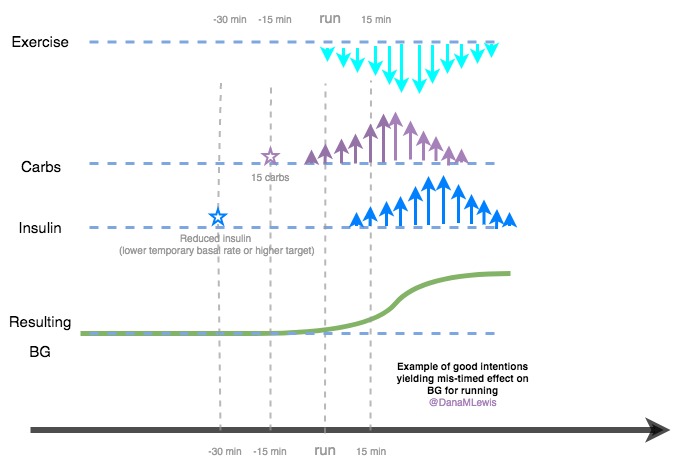
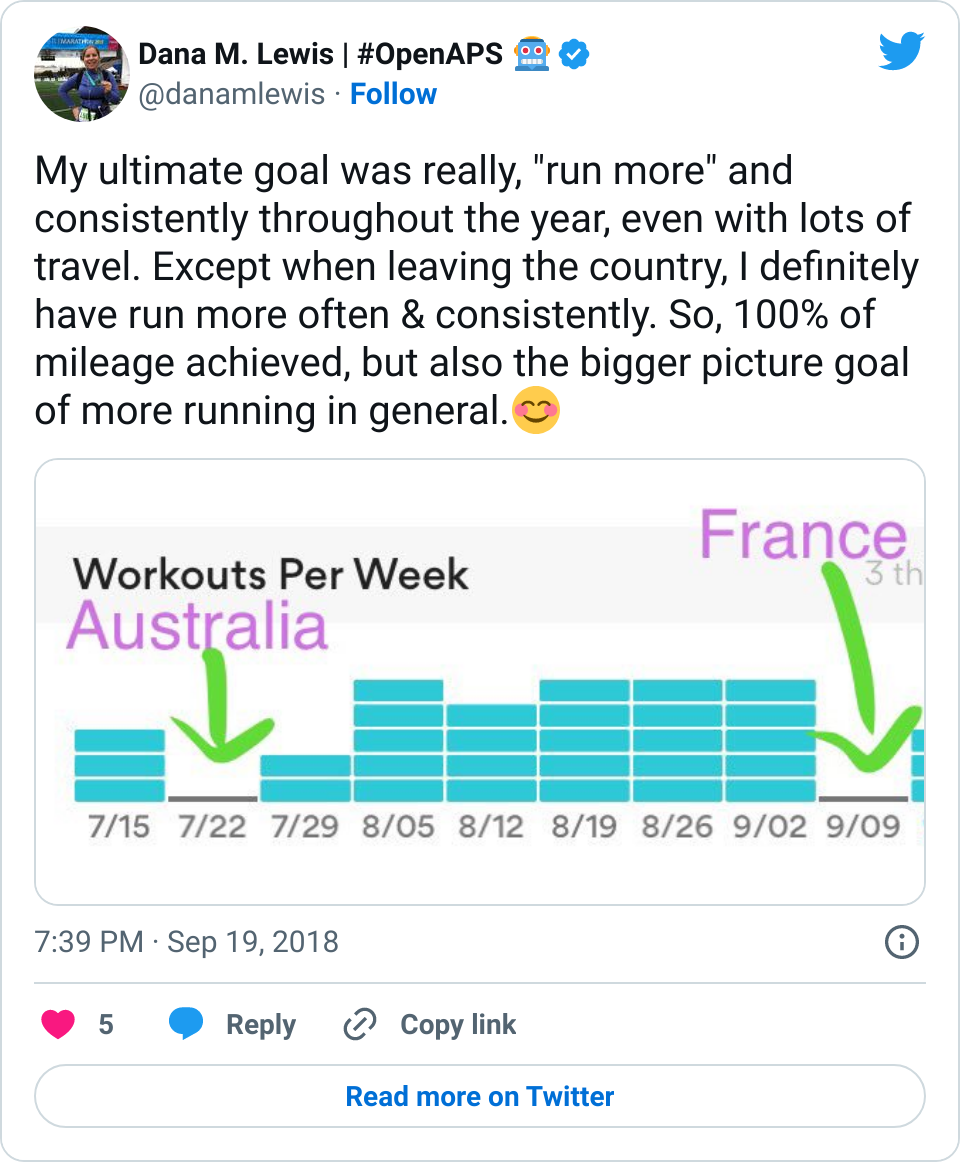
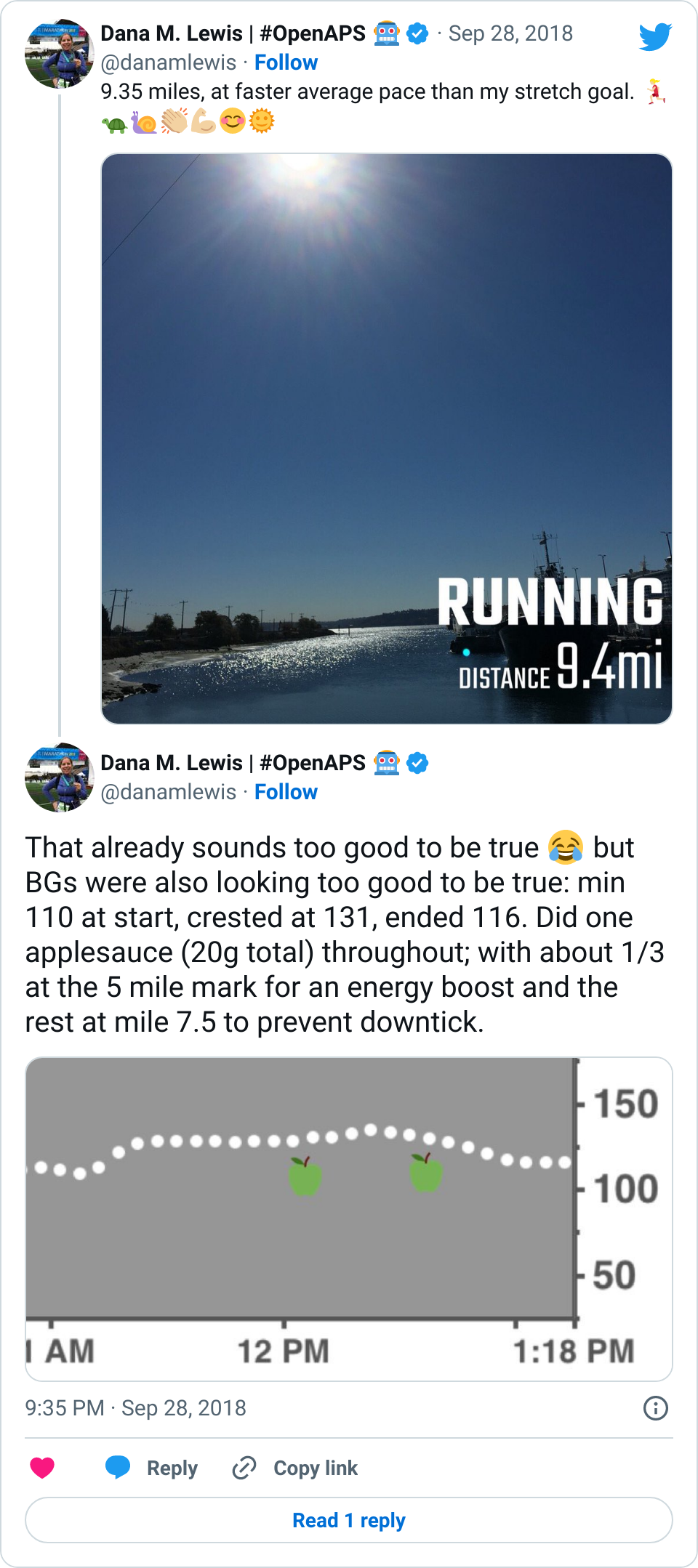
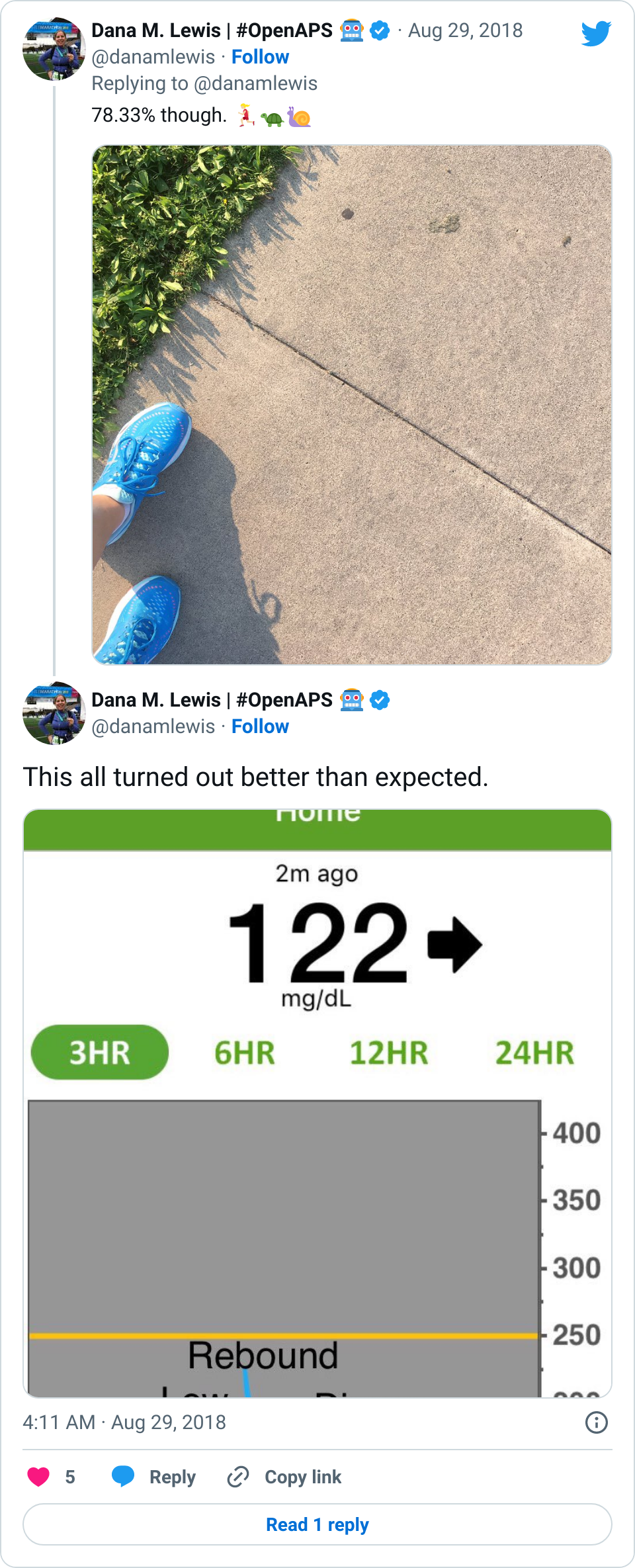
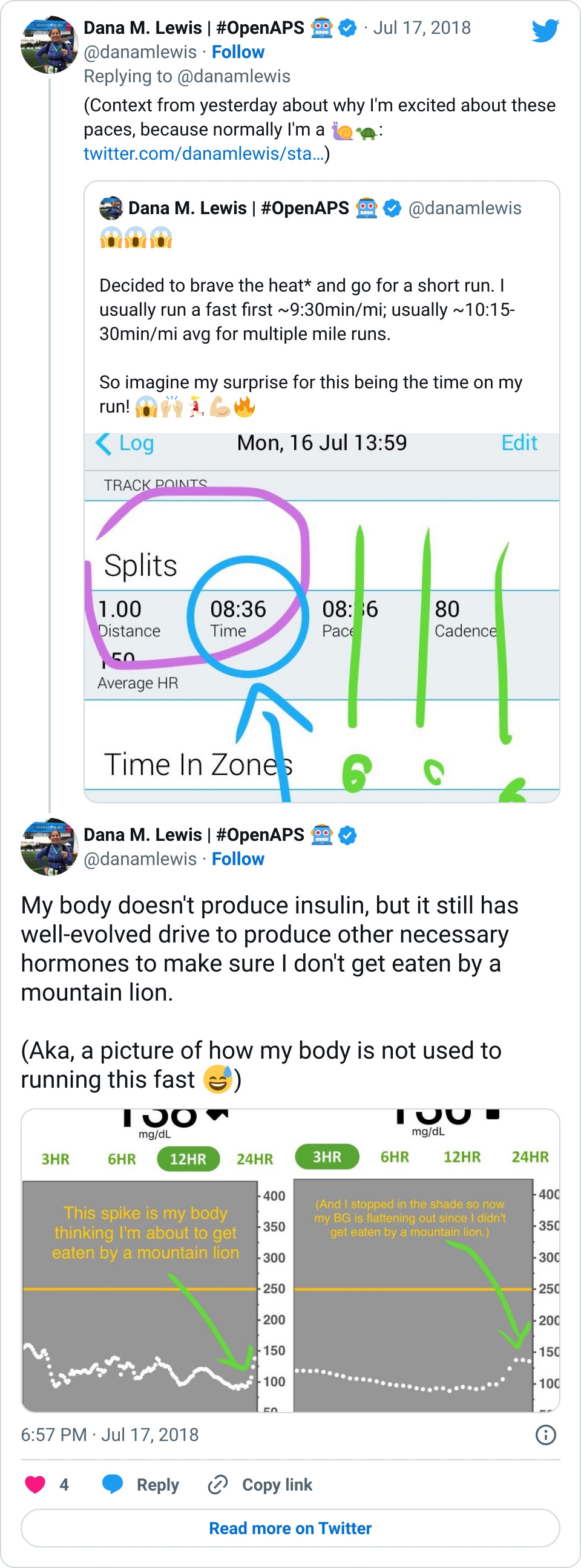
Recent Comments